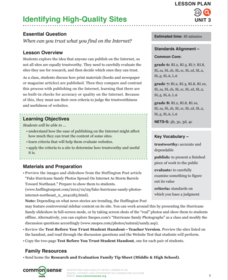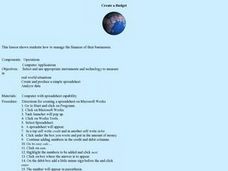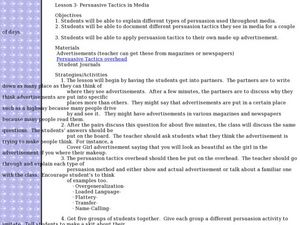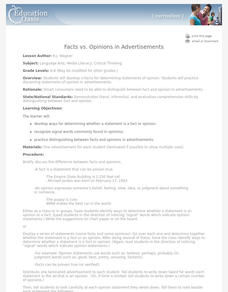Curated OER
Weekend With Wendell
Young scholars discuss prior knowledge about mice, and read a mouse poem. They listen to the teacher read "A Weekend With Wendell" and discuss Wendell's possible reaction when coming to visit the school media center. Students compose a...
Curated OER
Find a Book
Student receives one book description card and in less than 2 minutes, they walk through the Media Center to find a book matching that description. After a matching book is found, each student evaluates the book.
Common Sense Media
Identifying High-Quality Sites
Use a Huffington Post article focused on false pictures of Hurricane Sandy to launch a discussion about the reliability of online information. Groups compare and contrast how print and broadcast media regulate...
Curated OER
Create a Budget
Young scholars develop a budget spreadsheet to manage finances for their business. In this finance instructional activity, students use a spreadsheet program to create a budget with credit and debit columns. There are...
Curated OER
Persuasive Tactics in Media
Learners present a skit to the class and explain what persuasion tactic they used. In this persuasive tactics lesson, students discuss methods of persuasion used in various advertisements. The teacher leads and gives examples of...
Curated OER
Re-Searching
Students take a closer look at the research cycle. In this journalism lesson, students discover and practice Internet searching skills. Students use the search techniques discussed to locate information on selected topics.
Curated OER
Business Communication 1
Students examine a variety of methods that can be used to communicate information, and the process of communication. They analyze various business communication scenarios and write reports on their opinions of the situations.
Curated OER
Facts vs. Opinions in Ads
Middle schoolers develop criteria for determining statements of opinion. They practice discerning statements of opinions in advertisements.
Curated OER
Texture: Wild Things
Students experiment with different kinds of marking techniques. They read "Where the Wild Things Are" and observe animals for pattern and line. They compare illustrations with Haring's images. They create a symbolic drawing of animal.
Curated OER
Logos and Commercial Arts
Students identify popular logos and discuss the purpose they serve in advertising. They take a familiar logo and redesign it based on their own experience with the company it represents.
Curated OER
Americas Idols
Students engage in a lesson plan that is concerned with the concept of American Idol and the controversy that surrounds the broadcast. They conduct research using a variety of resources and write paragraphs that state opinions about the...
Florida Center for Reading Research
Phonological Awareness: Rhyme, Rhyme or No Rhyme
Rhyming is fun, builds phonemic awareness, and is a tried and true pre-reading skill. This activity helps learners identify words that rhyme. Young scholars listen to a song, locate a rhyming word they hear by clapping then draw a...
Howard Hughes Medical Institute
Zebrafish and Skin Color
You may not know if that zebrafish in your fish tank is a model citizen—but it is definitely a model organism! What can we learn about ourselves from a tiny zebrafish? Discover more about the polygenic trait of skin color through a...
Curated OER
My Credit Card Plan
Remember all those credit card tables lined up on your college campus? So alluring and dangerous, if you don't know what you're doing. Prepare your pre-college attendees for life by offering a lesson on credit management. They discuss...
Curated OER
The Fifty States
Students design a multimedia report on one or more of the fifty states.
Curated OER
Life and Art of Pablo Picasso
Art history projects can be a lot of fun. Budding art historians research the life, art, and times of Pablo Picasso, visit the local art museum, and create a multimedia presentation showcasing his art and personal history. Handouts,...
Curated OER
Understanding Library Skills: The Dewey Decimal System
Cyber Dewey? Dewey Made Fun? Do the Dewey Game? After a librarian-led tour of the school library and an explanation of the Dewey Decimal System, class members use the Internet to access MAGNOLIA, a site with resources devoted to library...
Curated Video
Privacy Part 2
Why is online privacy so important? Explore privacy with a group assignment for which pupils create word clouds with words they associate with privacy. A discussion and online activity follow. Learners will read articles, explore the...
Curated Video
Copyright
Introduce your class to the concept of copyright with a series of activities. Pupils first learn about copyright laws and fair use, putting their knowledge to the test with a quick categorizing task. They then watch a video and answer...
Curated Video
Policy - The Community Guidelines
Following a site's community guidelines is just one step toward being an excellent digital citizen. After a brief introductory video, small groups come up with their own community guidelines and present their ideas to come up with a...
Curated Video
Detecting Lies & Harmful Links
Who and what can you trust online? How do you know? After viewing a pair of introductory videos on positive and safe online conduct, learners discuss the content and put it into practice during an online search activity about alien...
Curated Video
Online Reputation and Cyber-bullying
Combat cyberbullying with information. During this plan, learners watch a couple of videos, consider online behavior scenarios, brainstorm long- and short-term consequences, and discuss how to react to bullying in order to build up to...
Curated Video
Reporting - Safety and Abuse Tool
Keep your charges safe online with instruction on how to report problems on YouTube. After providing learners with information on the Safety and Abuse Tool, demonstrate how to use the tool and discuss the feature. In groups, learners...
Curated Video
Reporting - Flagging
While it may feel like you can post just about anything on YouTube, that's not the case. Teach your class about flagging inappropriate content. Learners watch a demonstration, practice flagging, and answer questions about online content.























